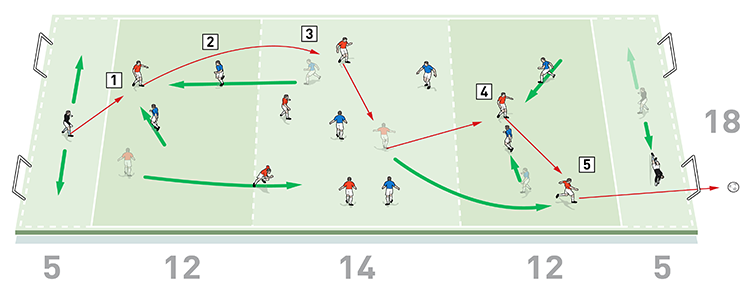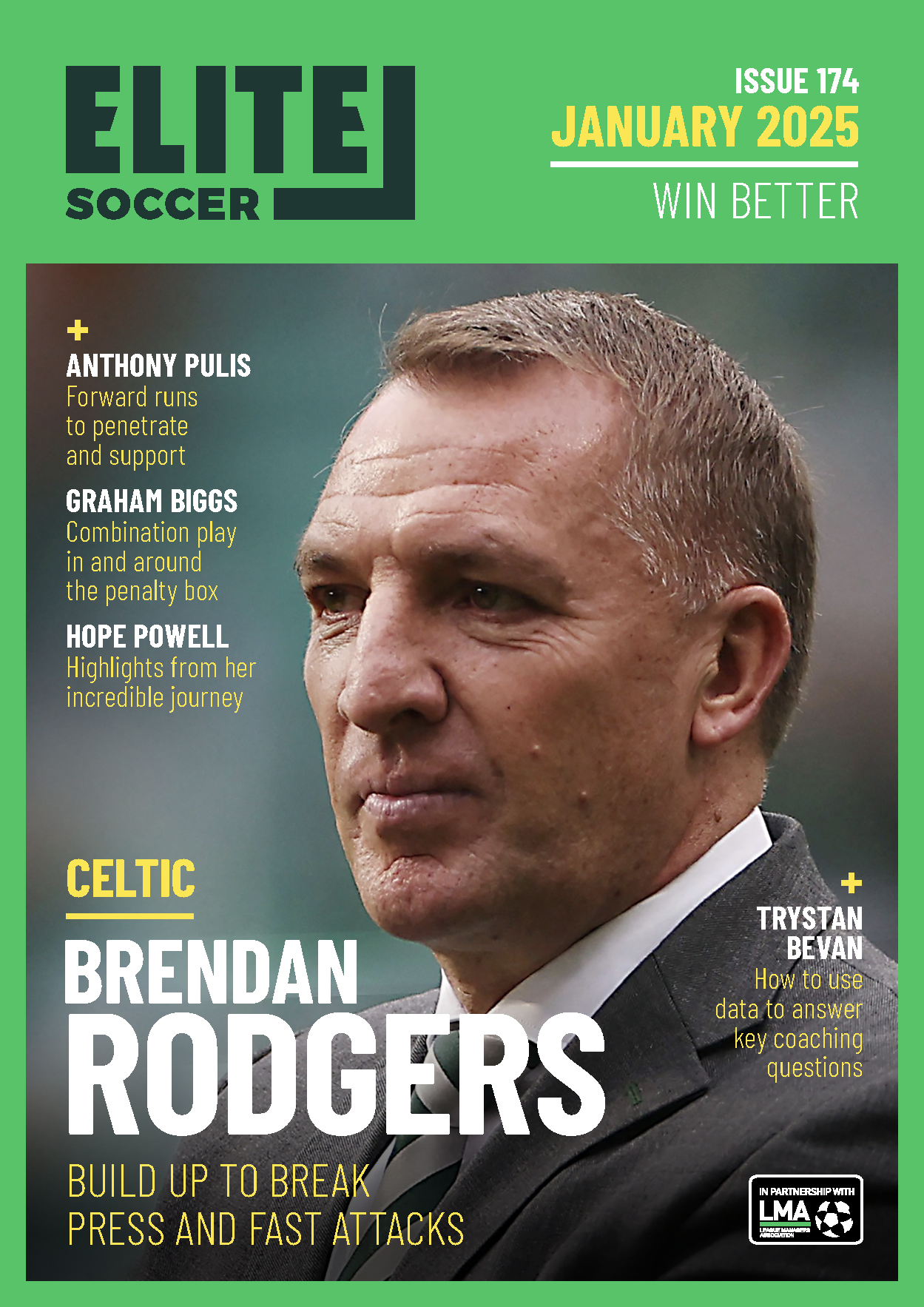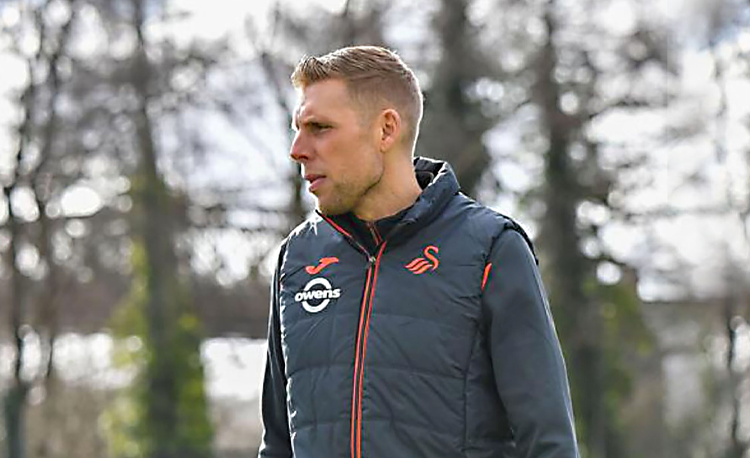You are viewing 1 of your 1 free articles
Post-match training
This is a session we actually ran after a pre-season game at Valencia this year. For the players that played more than 60 minutes of the game, their training would be focused on recovery and largely based on aerobic work, with some upper body weights and some time on the exercise bikes. But for the ones that played less than 60 minutes, we would run this top up session with the ball. It’s based in football and structured endurance.
| Area | Up to half a pitch |
| Equipment | Balls, bibs, cones, 3 poles, 4 small goals, 2 full size goals |
| No. of Players | Up to 14 players + 2 goalkeepers |
| Session Time |
Rondo: 15mins, Creating overloads: 15mins, Targeted stamina: 15mins, Small-sided game: 15mins |
This is a session we actually ran after a pre-season game at Valencia this year. For the players that played more than 60 minutes of the game, their training would be focused on recovery and largely based on aerobic work, with some upper body weights and some time on the exercise bikes. But for the ones that played less than 60 minutes, we would run this top up session with the ball. It’s based in football and structured endurance.
In attack, this session works on our possession and establishing our superiority in transition. We also work on the proper use of space. In defence, we work on closing space inside, pressing after losing the ball and recovering our shape on the transition from attack to defence.
We would run this session after every game, as the work is based on these principles – it’s a recovery session and a good, high-intensity workout with the ball for the players that either didn’t participate in the match or participated less minutes on the pitch.
RONDO
We set up a playing area of 16x8 yards divided into two halves. We’re using 12 outfield players split into two teams of six. Five reds start in one half along with two blues, while one red waits outside the end line of that half; three blues start in the other half and one blue waits outside the end line of that half.
The five reds pass the ball in their half and try to keep possession from the two blues, who press to cause a turnover. When the blues win the ball in this 5v2, they should immediately pass it to one of their three team mates in the other half, as shown [1a].
1a

2. Two blues press. When they win the ball they should immediately pass it to one of the three blues in the other half
Then the red player who lost possession, together with the red player waiting on the outside end of that half, should both chase the ball across the halfway line where they become the new pressers. The three blues are joined by their two team mates who have also followed the ball from the other half, making it a 5v2 in the new half, as shown [1b].
1b

2. The two blue pressers also follow the ball into the other half and join their three team mates in a new 5v2
3. The blues now pass the ball in their half under pressure from the two reds
4. One of the reds drops over the end line to become the new outside player at that end
Players are limited to two touches.
CREATING OVERLOADS
We set up a playing area of 48x18 yards divided into a 12-yard defending/attacking zone either side of a 14-yard central zone. We position two small goals at each end in a 5-yard zone that only the goalkeepers can play in.
We’re using 14 outfield players split into two teams of seven plus goalkeepers. Each team has two defenders, four midfielders and one striker and the players start in their relevant zones.
Play begins with a goalkeeper passing into the defensive zone, where his team have a 2v1 advantage. However, an opponent from the central zone can push into the zone to make it 2v2, applying pressure and forcing the possession team to play a long ball into midfield, either from the goalkeeper or from one of the centre backs.
Following the pass, the centre backs can split and if needed they can move into the central zone to create an overload or to assist by pressing or supporting their team mates.
The possession team should work the ball forwards, creating an opportunity to pass to the striker in the attacking zone. One of the midfielders can then enter the attacking zone to support the striker, making it a 2v2 attack, as shown [2].
2

2. An opponent from the central zone can push into the possession team’s defensive zone to make it 2v2
3. Under pressure from the blue midfielder, the possession team plays a long ball into midfield
4. The midfielders work the ball forwards, creating an opportunity to play a through ball to the striker in the attacking zone
5. One of the midfielders can enter the attacking zone to support the striker, making it a 2v2 attack
The goalkeepers guard both goals at their end and are limited to two touches. The outfield players have no limit on touches.
TARGETED STAMINA
We set up a playing area on just over half a pitch, with a goal and goalkeeper in their normal positions at one end and three poles positioned as shown. We’re using five outfield players.
Most of the players start on the halfway line of the pitch but two start diagonally opposite near to one of the poles. The players work their way around the circuit, shooting at the goal at one end before running around the goal and receiving a pass from – and returning it to – the next player.
They then complete the circuit with a sprint to the back of the starting queue, picking up a new ball along the way, as shown [3].
3

2. After receiving the return pass, the player shoots at goal and runs around the back of the goal
3. After receiving a pass from – and returning it to – the next player, he completes the circuit with a sprint around the pole behind the starting queue
4. The player then collects a new ball and joins the back of the starting queue, ready to go again
During the course of this circuit, players have the opportunity to work on various technical aspects of their game, such as passing, ball control and shooting.
SMALL-SIDED GAME
We set up a playing area of 30x24 yards with a goal and a goalkeeper at each end. We’re using 10 outfield players split into two teams of five. We play a 5v5 directional game plus keepers. Play starts and restarts with a ball from the goalkeeper and the possession team builds an attack on the other end, as shown [4a].
4a

2. The possession team builds an attack on the other end. There is no restriction on the number of touches players can take
If players try to score when they’re in the opposition half, all of their team mates except their keeper and all of their opponents must be in that half before they can shoot, as shown [4b]. However, the goal counts double if an opponent fails to drop back into their own half.
4b

2. The goal counts double if an opponent fails to drop back into their own half. Here the red defenders have all made it back in time
3. If a possession player shoots and scores from his own half, there is no restriction on which half the other players should be in for the goal to count
If a shot is taken from their own half, there are no restrictions. Normal offside applies. There is no limit on the number of touches players can take.
Related Files
Editor's Picks
Using the goalkeeper in build-up play
Pressing principles
Intensive boxes drill with goals
Penetrating the final third
Creating and finishing
My philosophy
Pressing initiation
Compact team movement
Defensive organisation
Coaches' Testimonials

Alan Pardew

Arsène Wenger

Brendan Rodgers

Carlos Carvalhal

José Mourinho

Jürgen Klopp

Pep Guardiola

Roy Hodgson

Sir Alex Ferguson

Steven Gerrard
Coaches' Testimonials

Gerald Kearney, Downtown Las Vegas Soccer Club

Paul Butler, Florida, USA

Rick Shields, Springboro, USA

Tony Green, Pierrefonds Titans, Quebec, Canada
Join the world's leading coaches and managers and discover for yourself one of the best kept secrets in coaching. No other training tool on the planet is written or read by the calibre of names you’ll find in Elite Soccer.
In a recent survey 92% of subscribers said Elite Soccer makes them more confident, 89% said it makes them a more effective coach and 91% said it makes them more inspired.
Get Monthly Inspiration
All the latest techniques and approaches
Since 2010 Elite Soccer has given subscribers exclusive insight into the training ground practices of the world’s best coaches. Published in partnership with the League Managers Association we have unparalleled access to the leading lights in the English leagues, as well as a host of international managers.
Elite Soccer exclusively features sessions written by the coaches themselves. There are no observed sessions and no sessions “in the style of”, just first-hand advice delivered direct to you from the coach.









